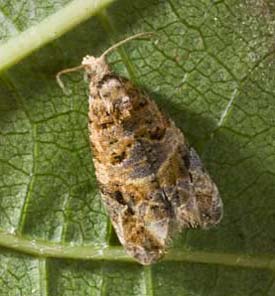 European Grapevine Moth,
European Grapevine Moth,  pests
pests  Wednesday, August 11, 2010 at 4:11PM
Wednesday, August 11, 2010 at 4:11PM Ever since phylloxera decimated the vineyards of Europe in the late 19th century and wiped dozens of varietals off the face of the Earth, growers and winemakers around the world have paid keen attention to new pests that might revive the specter of another grape holocaust. Phylloxera was brought from North America to Europe. This time the Europeans have returned the favor. The European grapevine moth has been found in several vineyards in the Napa Valley setting into motion a whirlwind of activity. Lobesia botrana has completely adapted its lifecycle to that of the grapevine. The adults first lay their eggs on the vines in summer. The caterpillars then eats the fruit and crawls underneath the bark of the vine to form their cocoon in which they reside through the next winter. The moth, originally from southern Italy, has now been found throughout Europe, Africa, the Middle East and Russia. The battle against this pest has been waged for more than a century.
 Lobesia botrana
Lobesia botrana
When the first vines in Europe started to inexplicably deteriorate, it was a long time before the nearly-microscopic phylloxera was discovered to be the culprit. It took even longer to determine how to combat the dreaded insect. Today, we benefit from a better understanding of ecology, sophisticated equipment and techniques, and agencies dedicated to protecting vital industries. The U.S. Department of Food and Agriculture has quarantined most of Napa County as well as parts of Sonoma and Solano counties and is trying to ascertain how it came to be here and what methods are needed to stop the spread. Strategies to combat the moth are already being implemented. One such attempt tries to mimic the female pheromone, luring unsuspecting males into a fruitless search for a mate and thereby interrupting the reproductive process. Another technique, with a nod to biodynamic principles, suggests promoting the populations of insectivorous bats and wasps that lay their eggs inside the moths. In California, traps have been set up throughout every grape growing region in the state to better understand the scope of the problem. Winemakers and growers are attending a series of seminars to become educated about the pest that are being hosted by the County Agriculture Commission.
 European Grapevine Moth,
European Grapevine Moth,  pests
pests